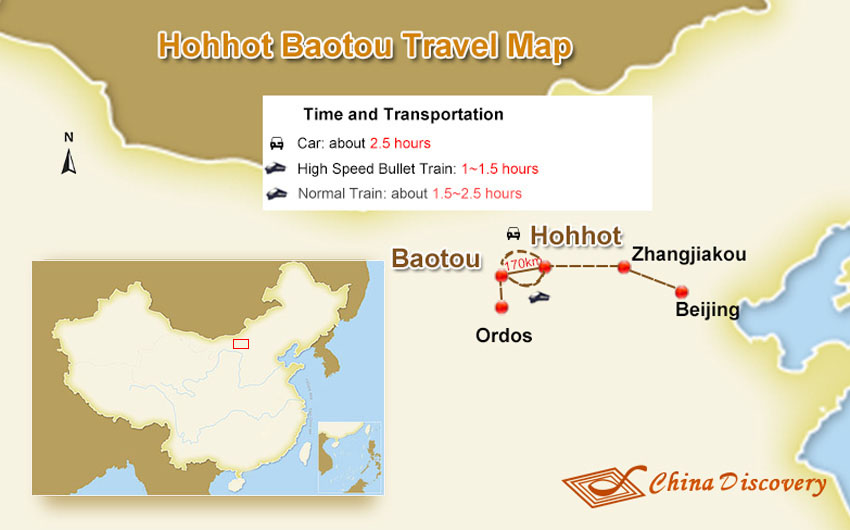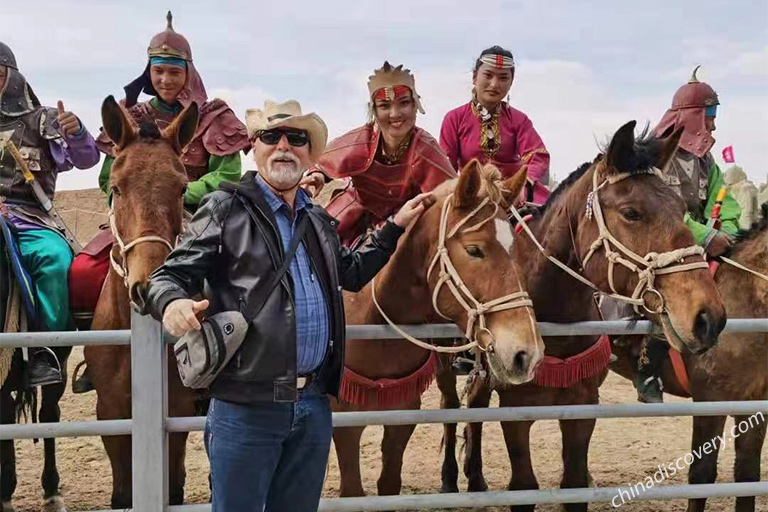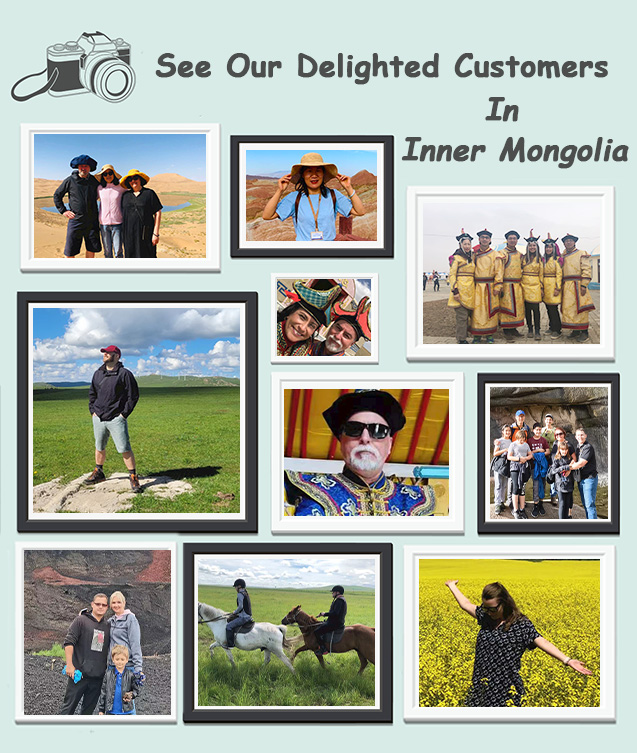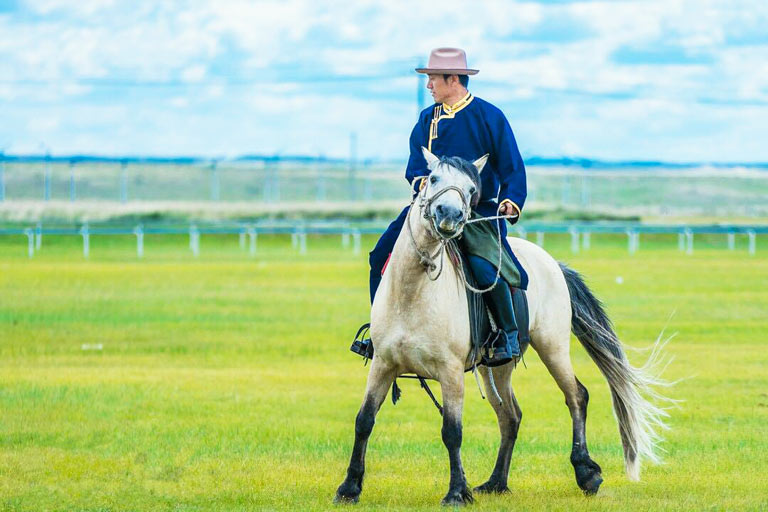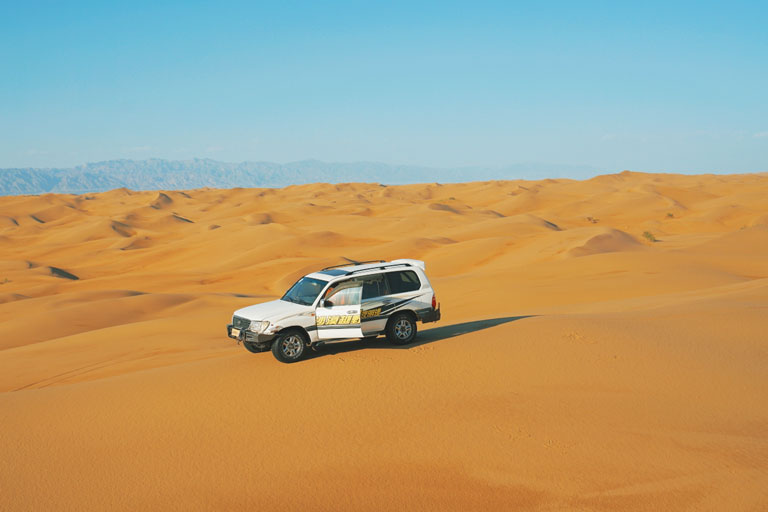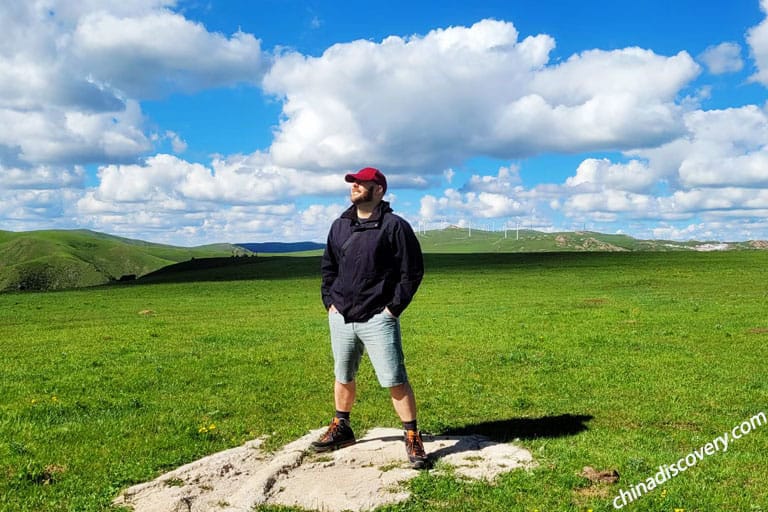Why Visit Wudangzhao Monastery?
Located at the southern foot of Jihuluntu Mountain, Shiguai District, Baotou City, Wudangzhao Monastery (五当召) is the largest and most complete Tibetan Buddhist temple in Inner Mongolia. It is praised as “the Potala Palace on the Grassland” and “the First Temple of the Northern Grassland”. Together with the Potala Palace in Tibet, the Tar Monastery in Qinghai Province and the Kangbuleng Monastery in Gansu Province, Wudangzhao is known as one of the four famous monasteries of Lamaism in China. Its unique resources contain rich knowledge of historical culture, religious culture, ethnic culture and geographical culture, known as a commanding point of Inner Mongolia and Baotou cultural & tourism resources.
About 40 kilometers from downtown Baotou, Wudangzhao was first built during the reign of Emperor Kangxi (1662-1722) and expanded several times during the reign of Emperor Qianlong, Emperor Jiaqing, Emperor Daoguang and Emperor Guangxu. It is a religious and political temple and a research base for Tibetan Buddhism (Tantra), philosophy, medicine, astronomy, geography and many other disciplines. In the Qing Dynasty, most of the abbots lamas in the nearly 1000 Tibetan Buddhist temples all over the Inner Mongolia prairie were sent from Wudangzhao, or had studied in Wudangzhao. Therefore, Wudangzhao is also known as the "Tsinghua University and Peking University”, the highest institution of Tibetan Buddhism in Inner Mongolia. Ever since the temple was built, it has been flourishing with worshipers. At its peak, there were more than 1,200 lamas and it enjoyed a high reputation in the Mongolian and Tibetan areas.
- 6 Days Inner Mongolia Bests Discovery Tour
- 6 Days Inner Mongolia Best Desert & Grassland Tour
Best Hohhot, Inner Mongolia Tours with Wudangzhao Visit:
Three Names of Wudangzhao Monastery
Wudangzhao has three names: Mongolian, Tibetan and Han. "Wudangzhao" is a Mongolian and Tibetan lingual blend name. "Wudang" means willow in Mongolian. The temple got the name because of the surrounding luxuriant willow and pleasant environment ."Zhao" in the Tibetan language, the original meaning is "brother", "Sakyamuni", extended to Buddha's temple; another Tibetan name of the temple is "Badagar", which means the white lotus flower. It is so named because of the legend that "the eagle holds the crown hada and leaves it here; the milk turned into white lotus blossoms here". It is called Guangjue Temple in Chinese and was granted by Emperor Qianlong himself in the 21st year of Qianlong (1756).
Interesting story about choosing Wudangzhao Temple site:
It is said that Wudangzhao was originally founded by the notabilities of the Left Front Banner of Ordos, and the temple site was chosen by the first Living Buddha Agwangqurimo. According to legend, Agwangqurimo studied Buddhism in Tibet. When he left Tibet, the Dalai Lama told him to "choose a blessed place to build a temple to worship Buddha and help all living beings". Arrived in Inner Mongolia, Agwangqurimo vowed to build a temple. Then, under the support of the notabilities of Zhunger Banner, he led two apprentices to travel all over the south foot of Yinshan and began to survey and site selection. The master and his apprentice boarded Sharqin Mountain. Looking as far north as they could, they saw the purple and misty smoke in the distance. Just then, a white-winged golden eagle swooped down, grabbed Agwangqurimo's crested hada and headed north. The master and his apprentices chased the eagle to a ridge platform. There was no sign of a golden eagle, but they saw a crested hada hanging from a cypress tree in the shape of a treasure canopy, which they assumed was the will of the Buddha. Suddenly, they heard a noise around them. It turned out to be a middle-aged Mongolian woman, holding a white calf in her left hand and a wooden bucket in her right hand. She put down the pail and turned to tie the calf to the pine tree, but the calf kicked the pail over and the spilled milk turned into white lotus flowers. While they were both surprised and delighted, the woman and the calf had disappeared. The Master knew that when Sakyamuni became a Buddha, lotuses grew at each step he walked, so the lotus was the symbol of the Buddha kingdom. The golden eagle is the guardian god of Shakyamuni Buddha. The appearance of golden eagles and lotus flowers indicates that this is the site of the temple. Finally, he decided to build a temple here, hence the name of the temple "Badagar", which means "the White Lotus".
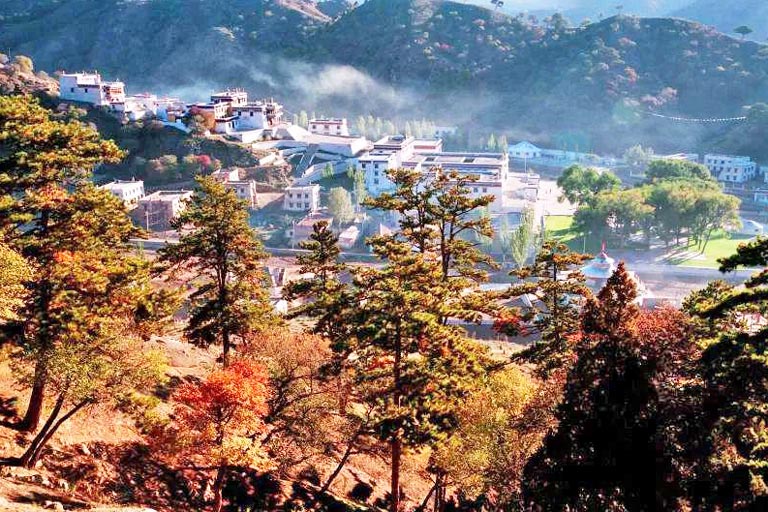 Wudangzhao Monastery (五当召)
Wudangzhao Monastery (五当召)
 Wudangzhao Monastery
Wudangzhao Monastery
Layout of Wudangzhao Monastery
Covering an area of more than 300 mu, with 2,538 halls and warehouses, Wudangzhao Monastery is grand in scale. The main building is located on the slope of the platform where two mountain gullies converge. On the east and west sides of the foothills and flat grounds, some ancillary buildings and monastic houses are distributed orderly, and there are also two eye-catching Tibetan white pagodas standing tall. The distribution of temples in Wudangzhao is reasonable and exquisite. Groups of temples and halls, layers of houses and pavilions built follow the terrain with a well-proportioned and harmonious layout.
All the buildings in Wudangzhao are trapezoidal building structures, narrow at the top and wide at the bottom, with small windows and flat roofs. The eaves are decorated with earth red sackcloth, golden Dharma wheel and red colonnade, which make a strong contrast in color and dazzle with brilliance. The exterior wall surface has a layer of lime several centimeters thick, clean and elegant, unique style. The exterior wall surface is covered with a layer of lime several centimeters thick, clean and elegant, unique in style. Overlook Wudangzhao from a distance, the halls are white like snow, the roofs are bright like gold, the scenery is quite spectacular. The temple of such a large scale and distinct structure is unique among the existing Tibetan Buddhist temples in Inner Mongolia.
 Panoramic View of Wudangzhao
Panoramic View of Wudangzhao
 Buildings in Wudangzhao
Buildings in Wudangzhao
Main Attractions and Highlights in Wudangzhao Monastery
The main building complex of Wudangzhao consists of 6 main halls, 3 Living Buddha Mansions, a Subogai mausoleum where the ashes of the Living Buddhas of the past dynasties are kept, and 94 residences(earth buildings) for lamas.
Suguqin Hall
Located at the front of the architecture group, Suguqin Hall is the largest building in Wudangzhao. It has 3 floors and covers an area of 1,500 square meters. The hall in front of the first floor is the Sutra Hall. There are 80 square columns with carves and colored drawing on the top and clouds and dragon tufted carpets covered the main body. The floor is lined with dozens of rows of couches covered with Tibetan carpets. The walls are covered with the stories of Shakyamuni Buddha and various images of Dharma Protectors. The top is hung with colorful streamers, and the palace is solemn and magnificent. The whole hall can accommodate more than 1000 lamas chanting sutras here. All big events and assemblies are held here.
Queyila Hall
Located on the west side of Suguqin Hall, Queyila Hall was built in the 15th year of Emperor Daoguang (1835). It is a department specializing in the study of Buddhist philosophy and has the largest number of monks. The largest bronze Maitreya Buddha of Wudangzhao is enshrined in Queyila Hall, which is ten meters high and made of brass.
Dongkuoer Hall
Dongkuoer Hall is the earliest hall of Wudangzhao, built in the 14th year of Emperor Qianlong (1749). The hall has three floors with a sutra hall in the front and a Buddhist hall behind. Its yellow exterior walls signify its noble status. In 1756, Emperor Qianlong granted the temple a name - "Guangjue Temple (广觉寺)". A plaque carved in Manchu, Han, Mongolian and Tibetan languages was hung on the lintel in the middle of the temple gate. This is the Department of Buddhist Chakra Mathematics, teaching astronomy, calendar, mathematics, divination and Tibetan calendar date calculation, etc.
Danggexide Hall
Danggexide Hall was built in the 15th year of the reign of Emperor Qianlong (1750). It is commonly known as "Xunfu Hall". It is also the temple of the guardian of Wudangzhao and Vajra Hall. The hall has 2 floors and is built close to Dongkuoer Hall.
Lamiren Hall
Lamiren Hall was built in the 18th year of Guangxu Emperor (1892), located on the northwest hillside behind the Danggexide Hall. It is the Department of Doctrine and Discipline, which was the only department established in Wudangzhao among the Tibetan Buddhist monasteries in Inner Mongolia. It is the latest built one in the Wudangzhao temple complex.
Jinke (Mandala) Hall
Originally known as Noony Hall, Jinke (Mandala) Hall was destroyed in the 1990s unrest and rebuilt on its site in 2003. The hall has two floors, and the first floor is the Buddha Hall. There are statues of Guanyin with Thousand Hands and Thousand Eyes, the Sixth Panchen Master and the Great Master Tsongkhapa. The murals painted on the walls are murals of the nine major Buddhist temples of Tibetan Buddhism. On the second floor of the hall is a museum of cultural relics, which displays some of the precious cultural relics preserved by the temple. There are collections like Thangka, Jingdezhen porcelain of the Qing Dynasty, musical instruments used in Buddhist masses, gilded mandala altar cities, etc.
Subogai Mausoleum
Subogai Mausoleum was once the residence of the I Living Buddha of Wudangzhao before the temple was built. "Subgai" means "pagoda" in Mongolian. It is a small Buddhist hall. Inside, the pagodas of successive Living Buddhas (the stupas) are enshrined.
 Suguqin Hall (苏古沁殿)
Suguqin Hall (苏古沁殿)
 Suguqin Hall Inside
Suguqin Hall Inside
 Dongkuoer Hall (洞阔尔殿)
Dongkuoer Hall (洞阔尔殿)
 Jinke (Mandala) Hall (金科(曼陀罗)殿)
Jinke (Mandala) Hall (金科(曼陀罗)殿)
 Subogai Mausoleum (苏卜盖陵)
Subogai Mausoleum (苏卜盖陵)
Wudangzhao Monastery Best Time to Visit & Photography Tips
Summer and autumn are the best seasons to visit Wudangzhao. Under the clear blue sky, the green vegetation and white Wudangzhao set off each other. Visiting Wudangzhao Travelers can not only enjoy the fresh and quiet natural scenery away from the hustle and bustle of the city, but also can feel the solemnity and sanctity of the Tibetan Buddhism culture. To know more about local weather, please visit Baotou Weather & Best Time to Visit >>
Photography Tips of Wudangzhao Monastery:
- Best Shooting Place: The Dongshan Pavilion (东山凉亭) in Wudangzhao is the best place to take panoramic photos of the temple. When shooting, the golden section method should be used for composition, and elements such as blue sky, white clouds and green mountains should be added appropriately. The best time of the day to shoot is in the early morning or late afternoon, which can fully show the spirit of Wudangzhao Temple.
- Besides photographing the panoramic scene of the temple, you can also choose one ancient building in the temple, or a part and details for close-up. The control of tone and light is very important for detail photography, which should focus on showing the sanctity and charm of the ancient temple.
- The precious cultural relics and some religious activities in Wudangzhao Temple are also good shooting material.
 Wudangzhao in Autumn
Wudangzhao in Autumn
 Ancient Buildings in Wudangzhao
Ancient Buildings in Wudangzhao
 Wudangzhao Humanistic Photography
Wudangzhao Humanistic Photography
How to Get to Wudangzhao Monastery | Location of Wudangzhao
Wudangzhao is located in Shiguai District, Baotou City. It’s about 58 km east from the center area of Baotou city and about 170 km west from Hohhot. Because it is far from the city center area, the public transportation of Wudangzhao is not very convenient. The most convenient way to get there is by booking a tour package with private car services.
Transfer to/off Wudangzhao Monastery by Private Car
There is a limited bus to Wudangzhao monastery (only 1~2 runs a day from Baotou downtown). To get rid of the hustle of public transportation and troublesome navigation, you can book a private tour package which covers sightseeing and transfers from us. Our knowledgeable local tour guide and skilled driver will escort you to Wudangzhao with speed and convenience, and take care of all the details.
Recommended Popular Baotou, Inner Mongolia Tour:
☛ 6 Days Inner Mongolia Bests Discovery Tour
Baotou to Wudangzhao Monastery
By Car: The driving distance between Wudangzhao and Baotou city center is around 58 km, which takes about 1.5 hours by car/taxi.
By Bus: There are 1~2 buses from Baotou (Baotou East Railway Station) to Wudangzhao every day, leaving at 9:00 in the morning and the whole bus journey takes around 2 hours. The return bus departed from Wudangzhao at 13:00 p.m.
(Notice: Bus information given above is only for your reference, might chance according to the real situation.)
Check more about How to Get to & Get around Baotou >>
Hohhot to Wudangzhao Monastery
Wudangzhao Monastery is about 170 km away from Hohhot city center. The only way to get from Hohhot to Wudangzhao directly is by booking a private car. The whole journey takes around 3 hours by car. Or you may take a (high-speed / bullet) train to get to Baotou first, which takes about 1~2 hours. Then transfer to Wudangzhao by car, taxi or bus from Baotou downtown.
Check more about Hohhot Transportation | How to Get to Baotou from Hohhot >>
 High-speed Trains to Baotou
High-speed Trains to Baotou
How to Plan a Baotou Tour
Best Time to Visit Baotou: May ~ October, especially in June, July, August and September…
How to Get There: Flights from Beijing (1.5hrs), Shanghai (3hrs), Xian (2.5hrs), Chengdu (2.5hrs), etc. and bullet train from Beijing (3.5-4hrs), Datong (3.5-4hrs), etc.
People usually take 2-3 days to explore diverse natural and cultural landscapes in Baotou. 1 day to visit famous Buddhist temples (Wudangzhao Monastery, Meidaozhao Monastery) and highlights in Baotou downtown; 1 day to visit Xilamuren Grassland (located between Hohhot and Baotou and closer to Hohhot city) and enjoy grassland activities and performances; 1 day to spend a relaxing desert vacation at Resonant Sand Bay and have fun with featured desert activities like camel riding and sand sliding, etc.; If you’re interested in desert hiking, you are recommended to spend more days extending to the more authentic Yemingsha Scenic Area. It usually takes 3 days to hike across the desert from east (Engebei) to west (Resonant Sand Bay).
☛ 2 Days Best Kubuqi Desert Tour to Yemingsha
More than 80% of tourists would start their Inner Mongolia trip from Hohhot and visit Hohhot, Baotou and Ordos together. A classic central Inner Mongolia trip takes about 5 days, which includes visiting famous Buddhist temples and historical sites, having fun in grasslands and trekking through deserts.
☛ 5 Days Classic Inner Mongolia Tour
☛ 4 Days Huitengxile Grassland & Kubuqi Desert Tour from Hohhot
☛ 4 Days Inner Mongolia Grassland & Genghis Khan Culture Tour
For those who have more time, may continue their trip to Hulunbuir (4~5 days), Badain Jaran (3~5 days), Xilingol (4-5 days) and Chifeng (4~5 days), etc. If you visit Inner Mongolia in autumn, don't miss the Populus Euphratica Forest in Ejina and the enchanting Arxan National Forest Park in Xingan League. Please feel free to tell us your likes and let our experienced travel consultant customize a tour for you!
Travel Baotou with China Discovery
Baotou and Inner Mongolia differ a lot with the classic mainland China you know. And it is not an easy job to arrange the daily flight, train and car travel at this relatively vast land. Therefore, travel with a professional travel agency is usually the best way to visit there. We China Discovery know Baotou and Inner Mongolia a lot and we are experienced in organizing tours to this region. If you need any help, please feel free to contact us! Private cars, one-to-one guide and travel consultant… Everything is only for you and your group or family! The tour is customized by your interest, budget, plan and every special need!
 Local Private Transfer Service
Local Private Transfer Service
- 6 Days Inner Mongolia Bests
- 6 Days Best Desert & Grassland
- 4 Days In-depth Hohhot Xilamuren
Baotou Tours
Baotou Travel Guide
- Popular Baotou Tours
- Baotou Travel Guide
- Top Attractions
- Xilamuren Grassland
- Get to Baotou
- Hohhot to Baotou
- Weather & Best Time
- Baotou Where to Stay
- Baotou Maps
More about Inner Mongolia Travel Guide
- Popular Inner Mongolia Tours
- Inner Mongolia Travel Guide
- Top Cities & Destinations
- Hot Attractions
- Things to Do
- Famous Grasslands
- Top Deserts
- Transportation
- Weather & Best Time
- Hotels & Where to Stay
- Maps
- Photos & Landscpaes
- Travel Tips
- Foods
- Naadam Festival
- Horse Riding
- Mongolian Yurts
- Inner Mongolia Tour Plan
Recommended Baotou Tours
Top 3 Baotou tours chosen by most customers to explore Baotou in the best way. Check the detailed itinerary, or tailor your own trip now with us.

6 Days Inner Mongolia Bests Discovery Tour
Hohhot / Ulanqab / Huitengxile Grassland / Hohhot / Baotou / Yemingsha of Kubuqi Desert / Ordos

6 Days Inner Mongolia Best Desert & Grassland Tour (Hohhot to Hulunbuir)
Hohhot / Baotou / Kubuqi Desert / Hulunbuir / Shiwei / Hulunbuir

5 Days Classic Inner Mongolia Tour
Hohhot / Huitengxile Grassland / Yemingsha of Kubuqi Desert / Hohhot
Start planning your tailor-made holiday to China by contacting one of our specialists. Once inquired, you’ll get a response within 0.5~23.5 hours.
Customize a TripHave a question? Get answers from our travel experts or guests
- Your Question:
- Your Name:
- Your Email:
- Submit



























